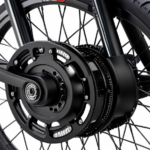As a dedicated electric bike enthusiast, I have discovered that knowing how to remove the rear tire is a crucial skill. By mastering this technique, you will be able to easily manage repairs or upgrades to your electric bike.
In this article, I’ll guide you through the step-by-step process, providing you with the necessary tools and equipment, and sharing my expertise on loosening the axle nuts or quick-release lever.
So let’s dive in and uncover the secrets to removing an electric bike rear tire.
Key Takeaways
- Safety precautions and proper preparation are essential before removing an electric bike rear tire.
- Shifting gears to the smallest cog and loosening the axle nuts or quick-release lever are important steps in the process.
- Sliding the derailleur away from the wheel and lifting the bike to remove the chain from the rear derailleur facilitate easy tire removal.
- Changing the inner tube and inspecting the tire for any damage or issues should be done before reassembling the rear tire.
Gather the necessary tools and equipment
Before you begin, make sure you have all the necessary tools and equipment. To remove an electric bike rear tire, you will need a few specific tools. First and foremost, you will need a wrench or a set of wrenches that fit the bolts holding the rear tire in place. Additionally, having a bicycle tire lever can be helpful for easily removing the tire from the rim.
Safety precautions are crucial when working with electric bikes. Always ensure that the bike is turned off and the battery is disconnected before starting any maintenance work. This will prevent any accidental electrical shocks and keep you safe throughout the process.
Now that you have gathered the tools and taken the necessary safety precautions, let’s move on to the next step. It is important to turn off the electric bike and disconnect the battery before proceeding with removing the rear tire. This will ensure that there is no power running through the bike and minimize the risk of any accidents or electrical malfunctions during the tire removal process.
Turn off the electric bike and disconnect the battery
First, make sure to turn off the e-bike and disconnect the battery. This is an important safety step to prevent any accidental power surges or electrical shocks while working on the rear tire. Locate the battery compartment, usually positioned near the rear wheel, and carefully disconnect the battery by following the manufacturer’s instructions. Once the battery is disconnected, you can proceed with removing the rear tire.
To remove the rear tire, start by shifting the gears to the smallest cog. This will ensure that the chain is properly aligned and provides enough slack to remove the wheel. Look for the gear shifter on the handlebars and shift until the chain is on the smallest cog. This step is crucial because it relieves tension on the chain and makes it easier to remove the wheel without damaging any components.
With the e-bike turned off, the battery disconnected, and the gears shifted to the smallest cog, you are now ready to move on to the next step of removing the rear tire.
Shift the gears to the smallest cog
Make sure to shift the gears to the smallest cog before proceeding to the next step. Shifting techniques are an essential part of maintaining your bike’s gears and ensuring smooth rides.
By shifting to the smallest cog, you relieve tension on the chain and derailleur, making it easier to remove the rear tire. To shift to the smallest cog, locate the gear shifter on your handlebars. Push the shifter inwards or downwards, depending on the type of shifter you have. This will move the chain onto the smallest cog at the rear of the bike.
It’s important to perform regular gear maintenance to keep your bike in optimal condition. This includes cleaning and lubricating the chain, as well as checking for any signs of wear or damage. By properly shifting to the smallest cog, you reduce strain on the drivetrain, prolonging its lifespan.
Now that you’ve shifted to the smallest cog, you can proceed to the next step: loosening the axle nuts or quick-release lever.
Loosen the axle nuts or quick-release lever
Now you can loosen the axle nuts or quick-release lever to continue with the process. To remove the rear tire of an electric bike, it is crucial to loosen the axle nuts or release the quick-release lever, depending on the type of axle your bike has. These components hold the wheel firmly in place, and loosening them will allow you to proceed with the tire removal.
To begin, locate the axle nuts or quick-release lever on the sides of the rear wheel. Using an appropriate wrench or your fingers, turn the axle nuts counterclockwise or release the lever to loosen them. Make sure to loosen both nuts or release both sides of the quick-release lever simultaneously to maintain balance and prevent damage to the wheel or axle.
Once the axle nuts or quick-release lever are sufficiently loosened, you can move on to the next step of the process, which is sliding the derailleur away from the wheel. This will ensure that the chain is properly disengaged from the gear system, allowing for a smooth removal of the rear tire.
Slide the derailleur away from the wheel
To continue, slide the derailleur away from the wheel to disengage the chain from the gear system. This step is crucial in order to safely remove the rear tire of an electric bike.
Before doing this, make sure you have the necessary tools needed for the job, such as a wrench or an Allen key, depending on the type of derailleur on your bike.
Common tire problems can range from a simple puncture to a worn-out tire tread. Whatever the issue may be, removing the rear tire is often required for repairs or replacements.
By sliding the derailleur away from the wheel, you create enough slack in the chain to easily remove it from the gear system. This prevents any unnecessary strain on the chain or derailleur during the tire removal process.
Once the chain is disengaged, you can proceed to lift the bike and remove the chain from the rear derailleur. This will allow you to fully separate the tire from the bike, making it easier to inspect and address any tire-related problems.
Lift the bike and remove the chain from the rear derailleur
Lifting the bike and removing the chain from the rear derailleur allows for a complete separation of the tire from the rest of the bicycle. To remove the chain, I start by lifting the bike and placing it on a sturdy surface. This ensures stability and makes it easier to work with.
Next, I locate the quick link or master link on the chain. By using a pair of pliers or a chain tool, I carefully remove the link and separate the chain. This step is crucial as it prevents any interference when removing the rear tire.
Once the chain has been removed, I can proceed to remove the rear tire. To do this, I gently pull the wheel out of the dropouts. The dropouts are the slots in the frame where the wheel axle sits. By pulling the wheel straight back, I can disengage it from the frame. It’s important to be cautious while doing this to avoid any damage to the derailleur or the wheel itself.
With the chain removed and the rear wheel pulled out of the dropouts, I am now ready to move on to the next step of the process.
Gently pull the wheel out of the dropouts
After gently pulling the wheel out of the dropouts, the next step is to proceed to the next part of the process.
To remove the tire and change the inner tube, start by flipping the bike upside down or using a bike stand to elevate it. This will provide better access to the wheel.
Locate the quick release lever or bolts that hold the wheel in place. If your bike has a quick release lever, simply flip it open and loosen the tension. If it has bolts, use a wrench to loosen and remove them.
Once the wheel is loose, carefully slide it out of the dropouts.
Now, it’s time to deflate the tire and remove the valve cap. To do this, press the valve core to release the air. Unscrew the valve cap and set it aside. This will allow the tire to fully deflate, making it easier to remove.
With the tire deflated, you’re ready to move on to the next step of the process.
Deflate the tire and remove the valve cap
The first step in deflating the tire and removing the valve cap is to press the valve core to release the air. This is an essential step in the process of replacing the inner tube and checking for punctures.
Here are four important things to keep in mind:
-
Safety first: Before starting the procedure, ensure that the bike is stable and secure. Use a bike stand or lean it against a wall to prevent any accidents.
-
Locate the valve: The valve is usually located at the center of the wheel, where the inner tube connects to the rim. It is crucial to find the valve before proceeding.
-
Press the valve core: Use your thumb or a valve tool to press down on the valve core. This will release the air from the tire, making it easier to remove.
-
Remove the valve cap: Once the air has been released, unscrew the valve cap counterclockwise and set it aside. This will allow for easier access to the inner tube.
With the tire deflated and the valve cap removed, we can now move on to the next step: using a tire lever to pry the tire off the rim.
Use a tire lever to pry the tire off the rim
To remove the tire from the rim, you can use a tire lever to carefully pry it off. Using a tire lever properly is crucial to avoid damaging the rim or the tire. Here are some common mistakes to avoid when removing a bike tire:
-
Applying too much force: It’s important to remember that the tire lever is a tool meant to assist you, not force the tire off. Apply gentle and consistent pressure to avoid bending the rim or puncturing the tube.
-
Using the wrong technique: Start by inserting the tire lever between the tire bead and the rim. Then, lever the tire lever down and away from the rim, using the spoke as a pivot point. Repeat this process around the entire circumference of the tire until one side is completely off the rim.
-
Not using enough tire levers: Some tires can be stubborn, so using multiple tire levers can make the process easier. Place the second lever a few inches away from the first one and repeat the levering motion.
Remove the inner tube from the tire
Using a tire lever, carefully pry the inner tube out of the tire.
-
Deflate the tire completely by removing the valve cap and pressing down on the valve stem. This will prevent any unnecessary strain on the inner tube during removal.
-
Starting at one side of the tire, insert the tire lever between the rim and the tire bead. Apply gentle pressure and slide the lever along the rim, gradually prying the tire off. Repeat this process on the other side of the tire until the entire bead is free from the rim.
-
Once the tire is loose, carefully pull the inner tube out from inside the tire. Be cautious not to pinch or twist the tube, as this can cause damage.
Removing the inner tube without damaging it is crucial for a successful tire replacement. It is important to handle the tube with care, avoiding sharp objects or rough surfaces. Additionally, proper tire inflation techniques should be followed to prevent future damage.
Inspecting the tire and inner tube for any damage is the next step in ensuring a safe ride.
Inspect the tire and inner tube for any damage
Check for any signs of damage on both the tire and inner tube before proceeding with the replacement. Inspecting tire damage is crucial to ensure a smooth and safe ride. Begin by examining the tire for any punctures, cuts, or bulges. Run your fingers along the surface to detect any abnormalities.
If you notice a small puncture or cut, it may be possible to repair the inner tube instead of replacing it entirely. To repair the inner tube, locate the puncture and mark it with a pen or chalk. Deflate the tube completely before applying a patch over the damaged area. Make sure to clean the surface with rubbing alcohol and allow it to dry before applying the patch. Press firmly to ensure proper adhesion. Once the patch is applied, inflate the tube slightly to check for any leaks. If there are no leaks, you can proceed with reassembling the tire.
Install a new or repaired inner tube
Now that you’ve inspected the tire and inner tube, it’s time to install the new or repaired inner tube. Here are the steps to follow for a successful installation:
-
Gather your tools: Make sure you have a tire lever, a new or repaired inner tube, and a pump handy. Having everything in one place will make the process smoother and more efficient.
-
Choose the right inner tube size: To ensure a proper fit, check the sidewall of your tire for the correct inner tube size. It’s important to match the size exactly to avoid any issues during installation or while riding.
-
Deflate the tire: Use a valve tool or your finger to press down on the valve and release any remaining air in the tire. This step is crucial to prevent any accidents or damage during the installation process.
-
Insert the inner tube: Starting at the valve, carefully insert the inner tube into the tire. Make sure it sits evenly and does not twist or bunch up inside the tire.
-
Align the tire bead: Once the inner tube is in place, begin aligning the tire bead with the rim on both sides. Use your hands or a tire lever to gently push the tire bead into place until it sits evenly on the rim.
With the new or repaired inner tube installed, you are now ready to place the tire back onto the rim.
Place the tire back onto the rim
Once you have successfully installed the new or repaired inner tube, it’s time to place the tire back onto the rim. This step is crucial in replacing the rear tire of your electric bike.
Begin by aligning one side of the tire with the rim. Using your hands, work your way around the rim, pushing the tire into place. Be careful not to pinch the inner tube between the tire and rim, as this can cause punctures. If you encounter resistance, check for any obstructions such as debris or misalignment. Adjust accordingly and continue pushing the tire onto the rim until it is fully seated.
Troubleshooting tire installation can be necessary if you encounter difficulties during this process. One common issue is when the tire is too tight and refuses to fit onto the rim. In this case, you can use a tire lever to assist you. Gently pry the tire onto the rim, being cautious not to damage the inner tube.
Another problem that may arise is when the tire is too loose and keeps slipping off the rim. In this situation, double-check that the tire is fully seated and try using a higher tire pressure to ensure a snug fit.
Now that you have successfully placed the tire back onto the rim, it’s time to move on to the next step: inflating the tire to the recommended pressure.
Inflate the tire to the recommended pressure
After you’ve placed the tire onto the rim, it’s time to inflate it to the recommended pressure. Checking tire pressure and maintaining proper tire inflation are crucial for optimal performance and safety.
To begin, locate the valve stem on the inner tube. Unscrew the valve cap and attach the pump nozzle securely onto the valve. Ensure a tight seal to prevent air leakage during inflation.
Next, refer to your bike’s manual or the tire sidewall for the recommended tire pressure. Using a tire pressure gauge, verify that the current pressure matches the manufacturer’s specifications. If the pressure is too low, add air in small increments, periodically checking the pressure to avoid overinflation. If it’s too high, release air by gently pressing the valve stem.
Once the tire reaches the recommended pressure, remove the pump nozzle and quickly secure the valve cap back in place. It’s important to note that underinflated or overinflated tires can affect the bike’s handling, traction, and overall performance.
Now that the tire is properly inflated, you can move on to reattaching the wheel to the bike and tightening the axle nuts or quick-release lever. This step ensures that the tire is securely fastened to the frame, preventing any potential accidents while riding.
Reattach the wheel to the bike and tighten the axle nuts or quick-release lever
To secure the wheel to the bike, make sure to tighten the axle nuts or quick-release lever.
After successfully repairing a puncture on the rear tire of an electric bike, the next step is to reattach the wheel securely to the bike. This process is crucial for ensuring a safe and smooth ride. However, there are some common issues that can arise when reattaching the rear tire, which should be troubleshooted.
Firstly, check the alignment of the wheel. It should be centered between the chainstays and the brake pads should be positioned correctly on the rim. If the wheel is misaligned, loosen the axle nuts or release the quick-release lever and adjust the position of the wheel accordingly. Once the alignment is correct, tighten the axle nuts or close the quick-release lever.
Secondly, make sure the axle nuts or quick-release lever are tightened properly. Use a wrench or your hands to tighten the nuts until they are snug. Avoid over-tightening as it can damage the axle or wheel. If using a quick-release lever, ensure it is fully closed and tightened.
Lastly, test the wheel to ensure it spins freely and without any wobbling. If there is any wobbling or rubbing against the brake pads, repeat the alignment and tightening steps. It is important to address these issues before riding to prevent accidents or damage to the bike.
Frequently Asked Questions
How do I know when it’s necessary to remove the rear tire of my electric bike?
To determine if you need to remove the rear tire of your electric bike, look for signs of wear and tear such as balding or cracking. If removal is necessary, follow the proper steps to reinstall the tire correctly.
Can I remove the rear tire without disconnecting the battery?
Yes, the rear tire can be removed without disconnecting the battery. However, it is important to ensure that the bike is turned off and the battery is securely in place before proceeding with the tire removal process.
What should I do if I encounter any difficulties when removing the rear tire?
If I encounter any difficulties when removing the rear tire, I should troubleshoot by checking for common mistakes such as improper axle tension or a stuck chain. I can also refer to the bike’s manual for specific troubleshooting steps.
Are there any specific tools required to remove an electric bike rear tire?
To remove an electric bike rear tire, you will need a few specific tools. A step-by-step guide will ensure success. Let’s dive in and explore the necessary tools and the process involved in removing the tire.
How often should I inspect the tire and inner tube for damage?
I inspect the electric bike tire and inner tube for damage regularly. I check for cuts, punctures, and wear. I also make sure the tire is properly inflated and the tread is in good condition. Maintaining proper tire pressure and avoiding rough terrain helps prolong the tire’s lifespan.
Conclusion
After following the steps mentioned above, removing an electric bike rear tire is a relatively straightforward process. It only requires a few tools and some patience.
Did you know that according to a recent survey, the sales of electric bikes have increased by 145% in the past year? With the popularity of electric bikes on the rise, it is essential for riders to be knowledgeable about basic maintenance tasks like removing a rear tire.
By learning these skills, you can ensure the longevity and performance of your electric bike.
















